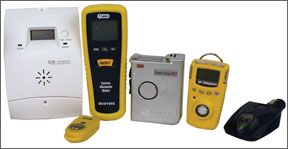If youre absolutely determined to kill yourself in an airplane, you’ll have to find a better way to do it than gassing yourself with carbon monoxide. The world is so awash with CO detectors across a range of prices and capabilities that we cant imagine many owners havent at least considered these gadgets. And the good news is that all of them work quite well, even, you might be surprised to know, the $4 cheapie stick-on detectors that all your friends tell you are a joke. (They arent.) How real is the risk of your exhaust or a perforated heater doing you in? Its real enough, although not the level of risk that should keep you awake at night. On the other hand, given the choices in detector technology, there’s no reason you cant eliminate the risk entirely or at least tamp it down. We were surprised to learn that the market has shifted quite a bit since we last examined detectors five years ago. There are many more small portable units and even a couple of panel mounts. We didnt attempt to try them all, but in this review, were examining some of the more prominent offerings, which offer more than enough choices.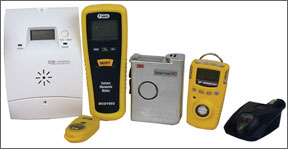
Three Categories
The gadgets sort into three basic categories: The familiar stick-on patch detectors that have been around since dirt was invented, sophisticated and sensitive portables and a line of panel mount devices dominated by a company called CO Guardian.
We obtained samples of each type and tried them in a shop-built gas chamber which we charged with low levels of CO from a laboratory-grade cylinder. We were able to expose the detectors to various levels of CO from under 100 PPM to several hundred PPM.
The important performance expectation is low-level sensing. Although the EPA says that acceptable levels of exposure in the workplace can be up to 50 PPM over an eight-hour period, as a certification requirement, the FAA requires that the cockpit have levels no higher than 50 PPM.
Yet at levels as low as 10 to 40 PPM, its possible to suffer symptoms of CO poisoning such as headache, blurred vision and impaired judgment. That last item is the main worry. Ten PPM isn’t much CO, but, like hypoxia, a mild case of CO exposure could lull you into a critical misjudgment or result in poor decision making
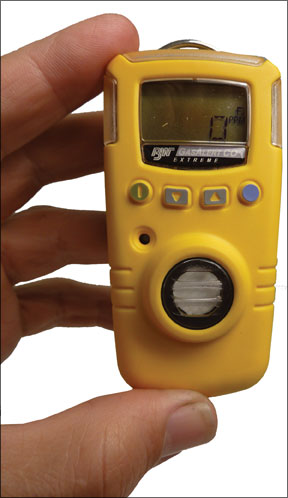
that youre not even aware of. It could be aggravated by hypoxia and while having oxygen aboard will help with that problem, it wont cure or prevent CO poisoning in a cockpit where exhaust is encroaching or the heater is compromised.
Thus, low-level detection (below 50 PPM) is preferred, as is an effective alarm or annunciation system. Although a display of the actual CO level is nice, its not a must, as long the detector alarms below 50 PPM.
Quest SafeTest 90
This compact portable has been our go-to detector for a number of years and it still is. Unfortunately, the company is discontinuing this model, but Sportys told us it still has a number in stock at $379.
The SafeTest is a proper gas detector, meant for industrial and scientific use and built accordingly, all housed in a robust plastic case. The price has gone up $84 since we last reviewed it, but we think its still a good value.
It uses an electrochemical sensor thats capable of detection down to 1 PPM, which it displays on a backlit LCD digital display. It will calculate time-weighted averages and short-term exposure limits, and will also record peak values.
The detector has a loud, warbling alarm and flashing red lights that are impossible to miss. Its so accurate, that we have used it as the benchmark to test the other detectors. But the others have upped their game so much that they all seem to agree on CO levels within a few dozen points.
Interestingly, time to first response is similar among all the units, which is to say they light up quickly when CO climbs above 50 PPM, but most pick up far lower levels, too.
BW Instruments
As Quest Technology exits the CO market, BW Technologies arrives, marketing a line of compact, sophisticated single-gas detectors, which include carbon monoxide. These replace the Honeywell Lumidor line, which has been discontinued. These were carried by Aircraft Spruce and we suspect theyll pick up the BW line as a replacement.
The company has two models, the GasAlertClip (about $200) and The GasAlertExtreme (about $240.) The Clip is intended as a disposable that operates continuously for two (or three) years once activated while the Extreme is switchable, with a field-replaceable 3-volt battery.
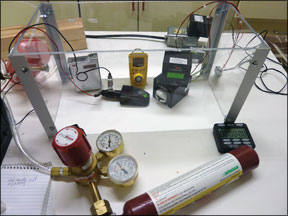
The GasAlertExtreme is about half the size of the SafeTest 90, with a small front-mounted digital display and a robust belt clip and hanging loop. The instrument is housed in a shockproof and immersible protective case.
The GasAlertExtreme reads CO values directly and also has low, high and weighted-average exposure calculations. Theyre also capable of datalogging through an optional cable. The detectors alarm limits are factory set at 35 PPM as a time-weighted average, but they can be reset in the field. In any case, the unit reads lower levels directly and alarms above 35 PPM. The alarm consists of flashing red LEDs and a beeper that is, in our view, a bit too low in volume to penetrate headset attenuation, so its important to keep the detector in the pilots or passengers view. It also has a vibrator feature.
CO Experts
For a number of years, aeromedix.com has sold the CO Experts unit ($179 retail) for aircraft, even though its intended for home or commercial building use. But the CO Experts detector has an important advantage over cheap hardware store detectors: It does low-level detection-as low as 7 PPM. Between 7 and 24 PPM, it emits a series of beeps once a minute, escalating to a beep series every 20 seconds, then every 10 seconds above 50 PPM.
These annunications are piercing and impossible to miss, meaning that the detector can be placed out of sight, if desired. Since its not intended for cockpit use, the best location for it might be on the cabin floor or a seat where it cant get kicked or damaged.
We noticed that this detector is extremely sensitive. It detected minute traces of CO from across the shop when we used a fan to clear small puffs of CO from our test chamber.
Pocket CO
At $129 from aeromedix.com and $125 from Aircraft Spruce, the Pocket CO 300 is the smallest of the portables-its literally a keychain device. Yet even so, it doesnt give up much to the higher-priced models, except for lack of low-level alerting. (It does sense and display below 50 PPM, but it doesnt alarm until above that level.) Like the other sophisticated portables, the Pocket CO calculates time-weighted averages and will warn if the average exceeds 25 PPM over an eight-hour period.
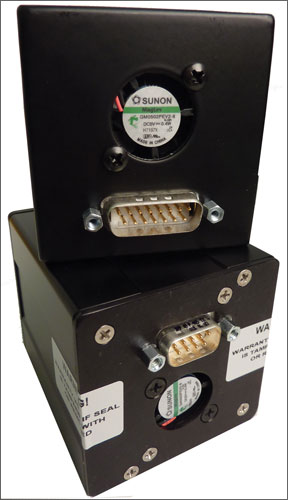
This detector has three alarm types: a vibrator, a buzzer and a tone-type alarm that we found to be moderately loud. It also has flashing alarm lights, so if its kept in sight, you wont miss its warning. The 50 PPM alarm can be set on or off, but the value cant be changed. Its powered by a CR2450 coin-cell, which can be field replaced.
CO Guardian
CO Guardian offers a full line of detectors with a focus on panel-mount devices. The closest thing it has to a portable is the Aero 152WD, a self-contained detector that plugs into an accessory cigarette lighter socket and remains constantly energized.
CO Guardian also provided us with two other representative models from its line, the Aero 452 panel mount and a newer product called the Aero 455, which uniquely combines a pulse oximeter with CO sensing and can output the data to a dedicated display (Aero 55) or to select MFDs through an RS232 data stream. These include the Garmin line, Electronics Internationals MVP-50 engine monitor and others.
The low end of the CO Guardian line is the plug-in 152WD at $149. It can operate on 12 or 28 volts. These units have two stages of alarms, flashing a yellow light when exposed to traces of CO (below 70 PPM) and red above 70 PPM. The detectors green light remains on if CO is below 50 PPM. There’s also an audible buzzer that we would call moderately loud. Its noticeable, but not as attention getting as the SafeTest 90 or the CO Experts.
Our trials of the Aero 455 and 452 proved impressive. At $459, the Aero 452 is a compact unit (1.5 by 1 .3 by 3 inches). It will operate on 12 or 28 volts and has a self-test feature. It alarms in five minutes or less-a lot less in our test-when the CO level reaches 50 PPM, at which point it flashes an amber light and emits a conspicuous tone. CO Guardian provides drawings and data for installation approvals in certified aircraft. Most of these, we suspect, will be field approvals.
A companion product, the Aero 455, is available in several variations. The version we tried consists of one module that houses the pulse oximeter and a second discrete unit (the Aero 55) that contains an LCD digital display. The display alternately shows pulse oximetry data (pulse and SPO2 oxygen saturation, plus CO level).
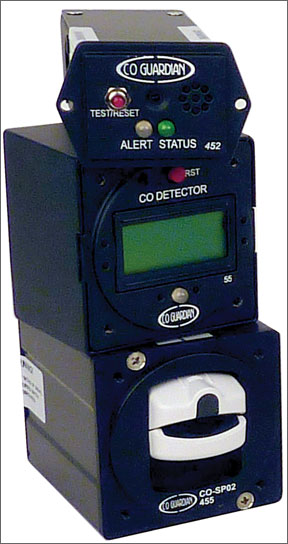
The 455s output can also be piped into the aforementioned MFDs, eliminating the requirement for the 55 display unit. If the display is needed, it costs $250, while the 455 sells for $895.
This product proved sensitive at detecting low levels of CO. It displays values above 10 PPM and alarms within three minutes above 50 PPM. The alarm is an impossible-to-miss piercing beep. We did notice that it didnt agree with the SafeTest 90 at high levels (above 500 PPM) of CO.
CO Guardian says its detectors are relatively maintenance free with a lifespan of five to seven years under ideal conditions. They recommend recalibration every five years, which costs $499 for the 455 and a flat $99 for the 152 and the Aero 452.
Conclusion
Were not convinced a CO detector is must-have equipment, but on the other hand, for not much money, you can protect yourself against the risk. Repeating the results of our last trial of these products, the SafeTest 90 is still our top pick. Sportys has a few left before its discontinued, so act quickly. Quest Technologies (a 3M company) told us it would continue to support these products, including calibration, so were not worried about it being orphaned.
So our new top choice in portables is the $240 BW Instruments Gas-AlertExtreme. Its comparable to the SafeTest 90 and its robust and easy to use. We were impressed with both the quality and performance of this instrument.
The Pocket CO 300 from Spruce and aeromedix.com isn’t a bad choice at $125, but we think the superior alarming features of either the CO Experts or the GasAlert are worth a little extra money.
CO Guardians panel devices are good performers and our first choice is the Aero 452 at $459. Although it doesnt alarm at low levels, its simple, always-on monitoring is, in our view, sufficient to reduce the CO risk substantially, which is all you can really expect of a carbon monoxide detector.

